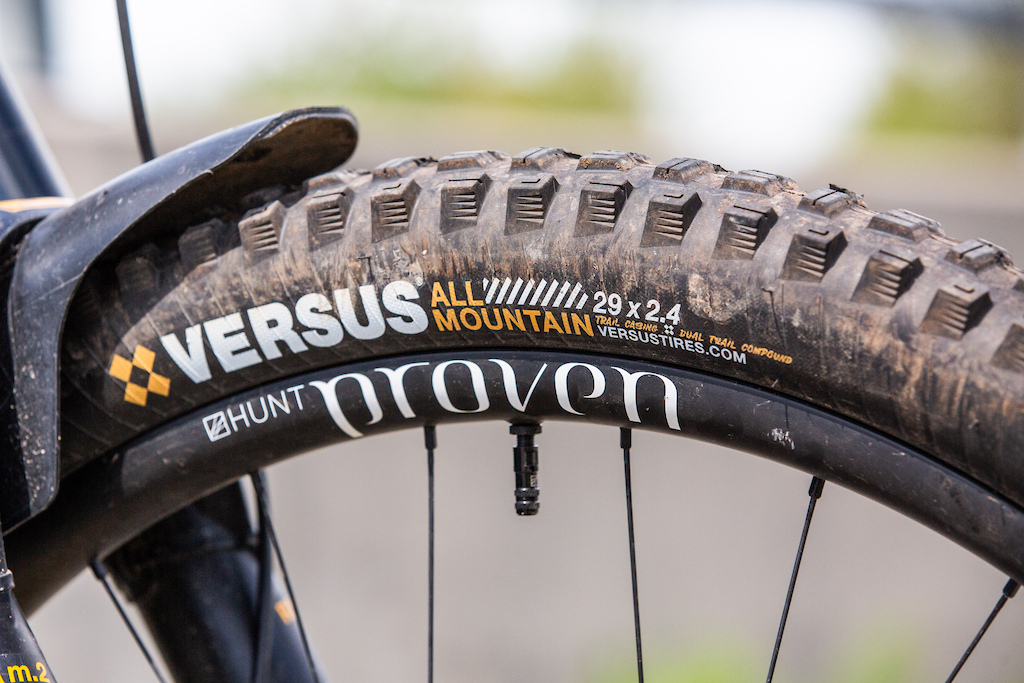
• 60/63a trail rubber compound
• Tubeless ready
• 3mm height center knobs
• Sizes: 29 x 2.4″, 27.5 x 2.4″
• Weight: 1056 g (actual 29 x 2.4″ Trail)
• MSRP: $68.50 USD
• www.versustires.com
There is an ongoing and similar process happening with tires, too, and hopefully the days of brands offering tires for north of $100 are nearing the end. Delium has been offering tires for around $50 – $60 USD, and just as a point of reference, of the more established brands, Continental’s more recent range does a good job of offering both value and performance. Especially for their thinner trail and enduro tires.
Versus has been in that same bracket for a while too, and we thought it was high time they got a review. The brand, which started out as direct-to-customer but is now being rolled out across select retailers, doesn’t do too much in the way of thrills, save for some splatter colorways. They offer one tread pattern, which they name as All Mountain, in two casings – Trail and Gravity. You can get these tires singularly, in pairs, or even a three-set with free US shipping when spending over $100.
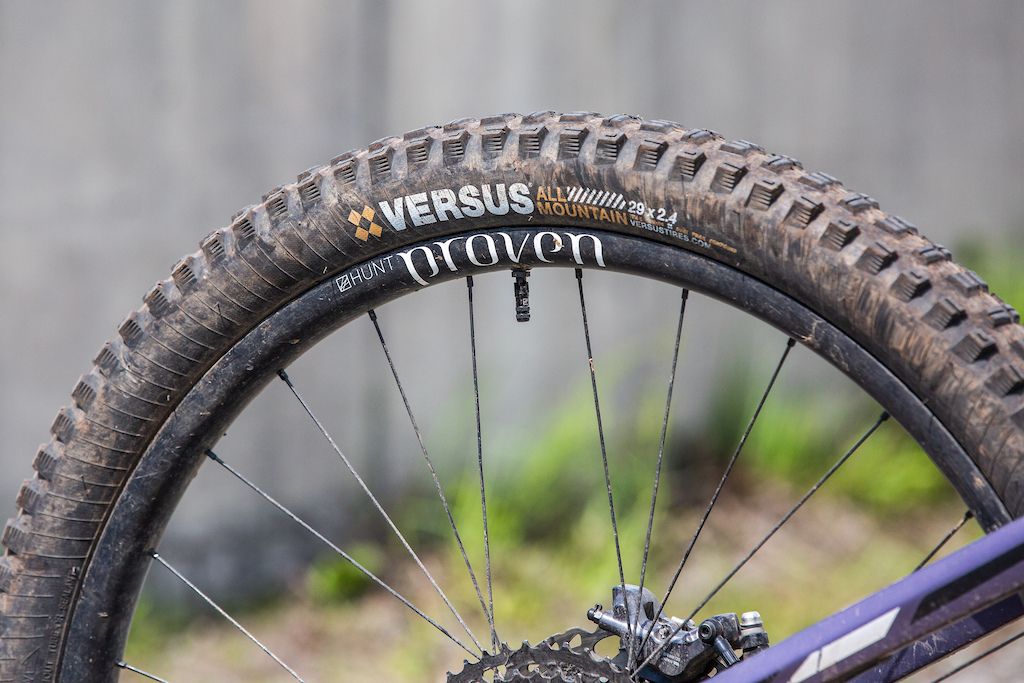
Details
Here, I’ve reviewed the All Mountain tires in the Trail Casing, which have an actual weight of 1056 grams. The tires are intended to be used with rims that have a 30 mm internal rim width. At the widest part of the tread, the tire is 60 mm wide (2.35 inches). At the sidewall, they actually swelled out slightly and measured 61.5 mm.
To look at these tires, they seem to offer something of a halfway house between the DHF and the DHR2. The braking paddle of the latter is present, but so too is the directional toe-in center knobs that you’d find on the former. The center tread has a healthy offset to the edges to hopefully stop any rocks or square edges from falling between them and contacting directly onto the rim under high load. However, a stark difference to the very well-established Maxxis offerings is the low profile 3 mm lugs.
The Trail tires have a folding aramid bead and single wall sidewall. They use a dual compound 60/63 durometer rubber compound and are available in a 2.4″ width. The Gravity casing uses a slightly softer compound (52/58 ), a wire bead, and a dual wall sidewall and weighs 400 g more.
I have spent some time on the 1450-gram tires, even going as far as proclaiming that heavy bikes are always better. While it’s true that one can yield greater performance when low weight isn’t such a priority, at nearly a kilo-and-a-half they’re certainly portly. When riding the Gravity model it’s clear that so much of that weight is in the wire bead. I was still able to use the full stroke of the tire and had my rims howling several times. For all that weight, I’d prefer a bit more sidewall support. The compound is good though, and they hooked up well even over the wet and slippery roots of a Canadian winter. Although I do like them, personally, if I’m going that heavy I want a tire that can really make do without inserts.
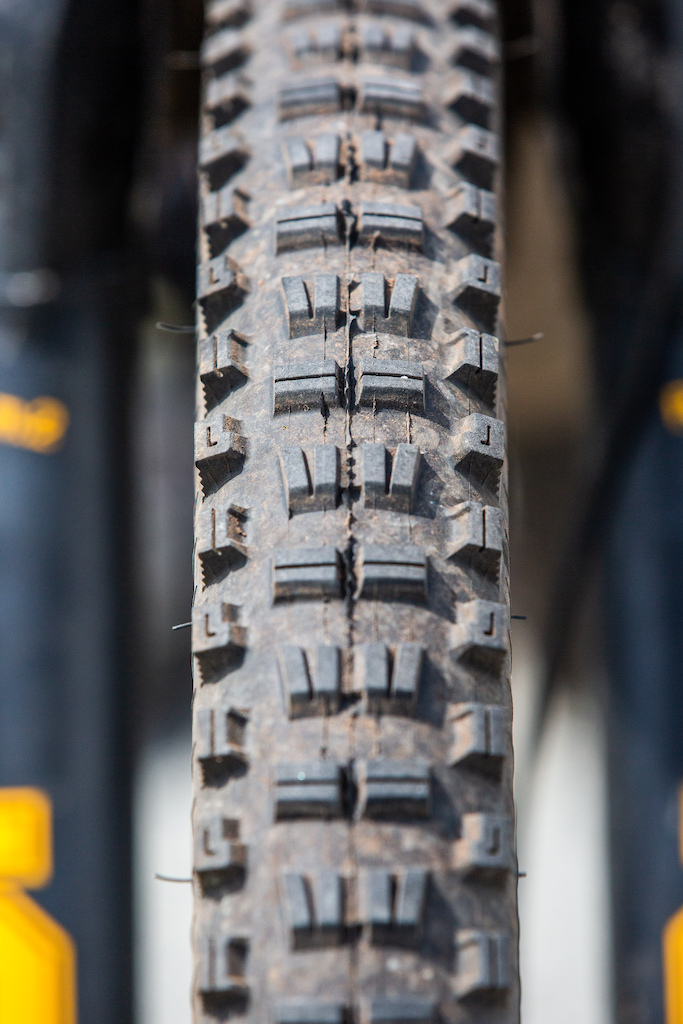
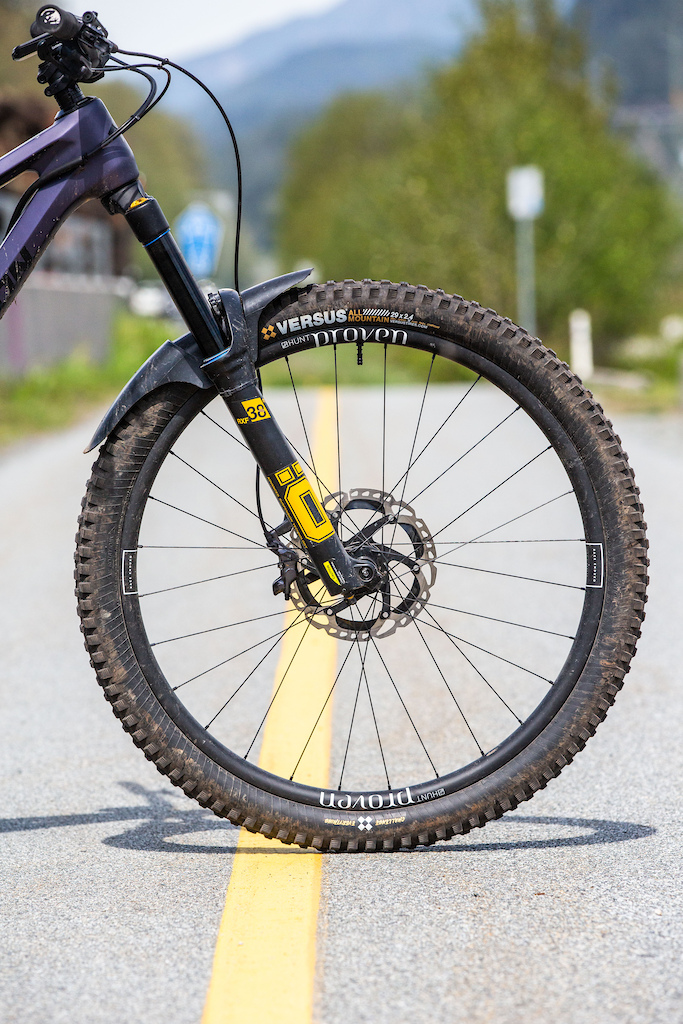
Performance & Impressions
The tires took to a tubeless setup easily and popped straight onto the bead with a normal track pump. They were also relatively easy to get into the well of the tire.
The tire, much as its looks would suggest, offers many of the same traits as the DHR2, but its ride characteristics aren’t entirely identical. The All Mountain tread isn’t quite as tall as other tires in the category. This is good in some ways, and bad in others.
The Versus is very good at going between edges, and changes direction well. In fact, the center knobs do an admirable job of all that they can get their hands on. The braking is good, I never suffered any punctures and they roll very adequately. They’re not the best on rocks, with the knobs not biting and gripping quite how I would like, but what they lack in that area they make up for on drier or more compacted man-made trails. I do feel though this rubber is on the harder side of what I’d like. The tire has a tendency to sound as if it’s scraping rather than biting.
Truthfully, the mud here in Squamish isn’t claggy or clay-based, so I can’t comment on how well these tires shed mud in the absolute worst of conditions, but even here they did sometimes threaten to get slightly overwhelmed on wet, soft trails. Although they do work better than their small lugs might leave you to believe, there were times on really loamy or wet dirt where they struggled to clear quickly, or feel like they were able to sink into the trails.
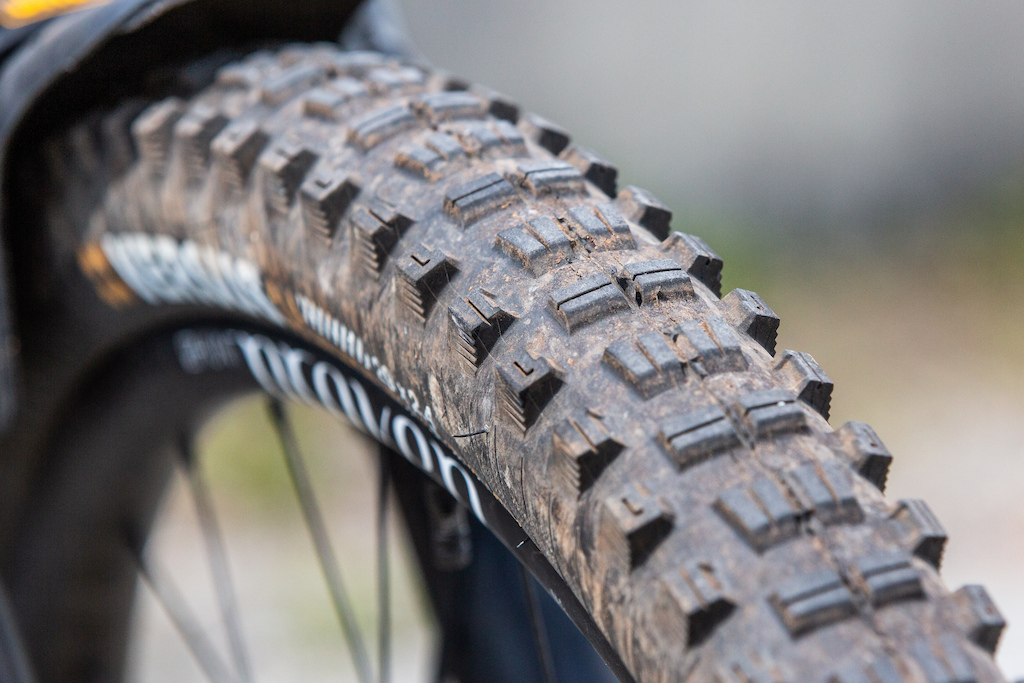
Riding these tires is a tale of two halves. In some ways, it seems very apt that my initial visual comparison drew up qualities of both the DHF and the DHR2, both of which have a reputation of being run on the front or the rear. In my experience though, the DHF embodies many of the traits I’d like of a front tire (lots of security when leaning the bike) and the DHR2 offers the qualities I like in a rear – a good braking edge and predictable transfer across the tire when going from one edge to another. That said, they both do well being used either front or back.
While the All Mountain tread does offer similar characteristics to the DHR2 in many situations – for instance, the braking or the quick transfer from edge to edge, I don’t think they offer the same level of support when truly leaned over, likely because the edge knobs are slightly small and shorter than one might hope for. Getting the bike leaned is guided with confidence but when you’re really pushing into the shoulder of the tire it has a tendency to feel vaguer and begin to wash.
This isn’t something that undermines my confidence on the rear, and in fact, in the right situation it can really help you get the bike rotated in the turns, but on the front, it’s just a bit too vague for me. It should be said though, that even at that point it’s more of it gradually getting away from you than it snapping from one moment to the next.
The rubber compound itself is on the harder side. Although the grip is reasonable, you could notice that as it began to deflect or slide off roots in the wet. It certainly can also get a little frisky when braking hard on rock slabs, with the tire feeling more as if it’s scratching over the stone rather than trying to really grip against it. The rocks here in Squamish are very grippy in the wet, but I did have one or two moments when the rear wheel was threatening to break away under braking a little easier than I would hope. On smoother trails or in a bike park setting the tire really performs well. There are times when I would prefer more shoulder, but all in all they’re solid, if not spectacular.
In the dry, these are a fun, consistent tire that hops between edges in a secure and predictable manner, even if they’re lacking some support when leaned over.

Durability
The tires have offered admirable durability. Even the rear isn’t showing signs of shredding or peeling. The sidewall is also right on the money in terms of support for its 1 kg. I would love, however, to see the sidewall of the heavier Gravity tire on the bead of the Trail option. In some ways, what I would recommend is getting your favorite Assegai or Kryptotal Front, in the fancy premium rubber, and then buying these in bulk for the rear and spending the money where it really counts. This is a good tire, but its characteristics definitely suit the demands of a rear wheel more than the front.
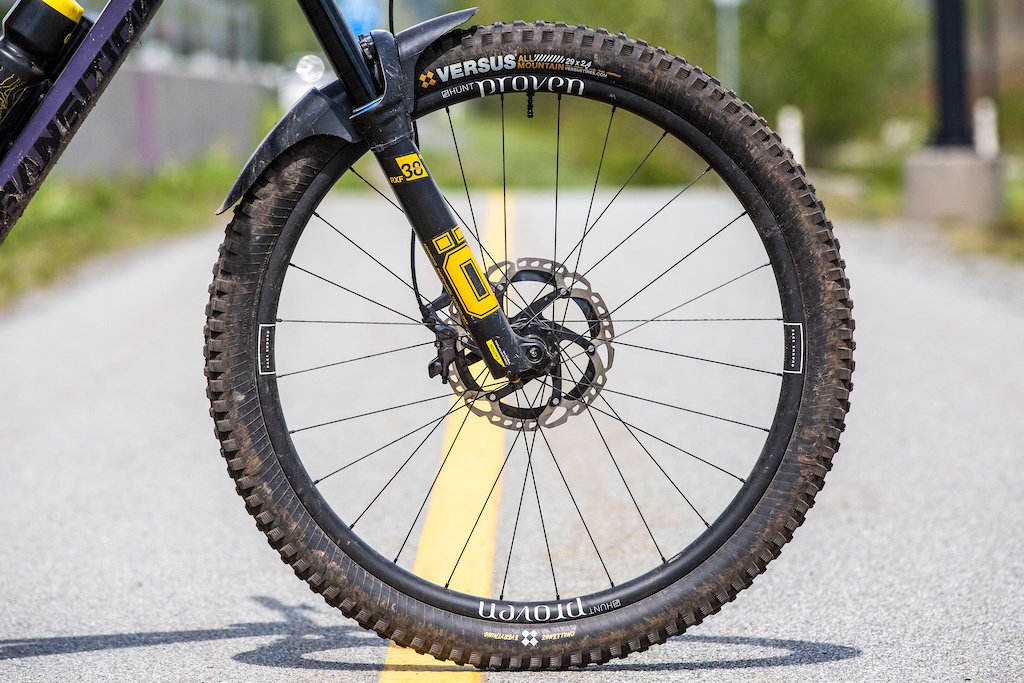
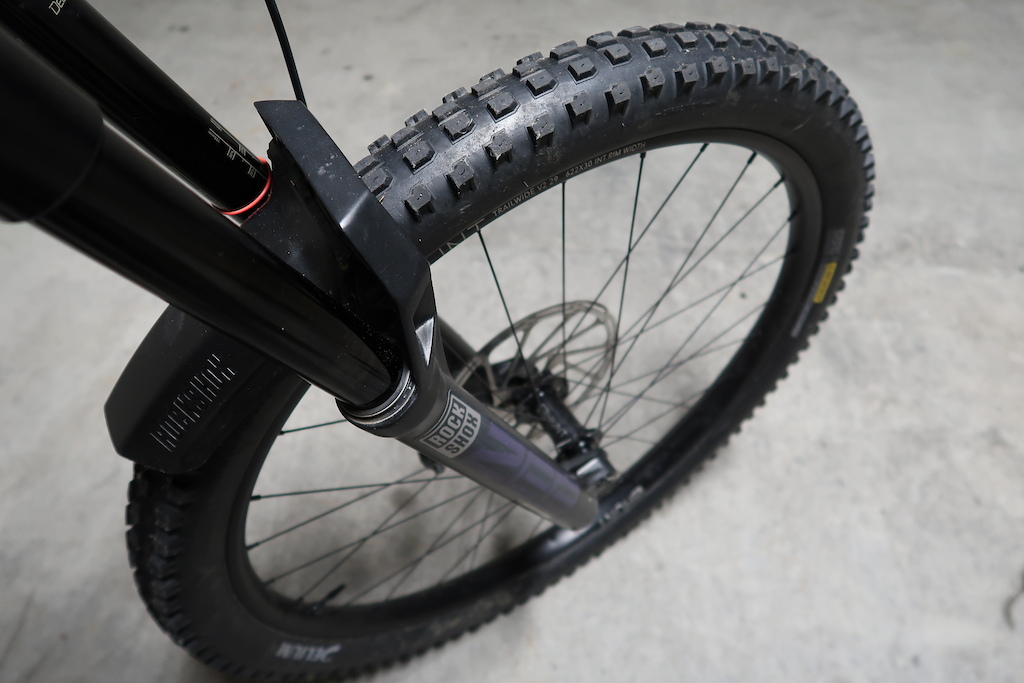
Comparison
Last year, I reviewed the Delium Versatile. Delium is also a brand that also aims to bring value to the consumer through its own sales model. How do they compare? Well, they’ve both clearly taken inspiration from some of the tires I’ve already mentioned. For all-year riding, the Versatile does exactly what it sets out to do and offers a tire that will perform well in nearly all conditions. However, when it’s slightly more hardpack or drier, I would say the consistency of the Versus can’t be ignored, especially as you roll the bike between turns and feel the bike flit from one edge to another. In some ways, between these two brands, you’ve got two good value tires that will mimic the famed performance of the DHF and DHR2 combination after all.
+ Gradual and consistent going from edge to edge
+ Offers good value, especially on bulk buys
+ Work well on most surfaces, but prefers drier firmer conditions
+ Rolls well
– Could offer more support from the shoulder of the tire when leaned over
– Didn’t feel particularly grippy in the wet
– A softer compound would be nice for rocks and slabs.
Pinkbike’s Take

